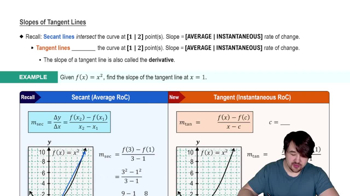Table of contents
- 0. Functions7h 52m
- Introduction to Functions16m
- Piecewise Functions10m
- Properties of Functions9m
- Common Functions1h 8m
- Transformations5m
- Combining Functions27m
- Exponent rules32m
- Exponential Functions28m
- Logarithmic Functions24m
- Properties of Logarithms34m
- Exponential & Logarithmic Equations35m
- Introduction to Trigonometric Functions38m
- Graphs of Trigonometric Functions44m
- Trigonometric Identities47m
- Inverse Trigonometric Functions48m
- 1. Limits and Continuity2h 2m
- 2. Intro to Derivatives1h 33m
- 3. Techniques of Differentiation3h 18m
- 4. Applications of Derivatives2h 38m
- 5. Graphical Applications of Derivatives6h 2m
- 6. Derivatives of Inverse, Exponential, & Logarithmic Functions2h 37m
- 7. Antiderivatives & Indefinite Integrals1h 26m
- 8. Definite Integrals4h 44m
- 9. Graphical Applications of Integrals2h 27m
- 10. Physics Applications of Integrals 2h 22m
3. Techniques of Differentiation
Derivatives of Trig Functions
Problem 3.5.75b
Textbook Question
Use a graphing utility to plot the curve and the tangent line.
y = cos x / 1−cos x; x = π/3
 Verified step by step guidance
Verified step by step guidance1
First, understand the function y = \( \frac{\cos x}{1 - \cos x} \). This is a rational function where the numerator is \( \cos x \) and the denominator is \( 1 - \cos x \).
Next, find the derivative of the function to determine the slope of the tangent line at \( x = \frac{\pi}{3} \). Use the quotient rule: \( \frac{d}{dx} \left( \frac{u}{v} \right) = \frac{u'v - uv'}{v^2} \), where \( u = \cos x \) and \( v = 1 - \cos x \).
Calculate \( u' \) and \( v' \). For \( u = \cos x \), \( u' = -\sin x \). For \( v = 1 - \cos x \), \( v' = \sin x \). Substitute these into the quotient rule formula.
Evaluate the derivative at \( x = \frac{\pi}{3} \) to find the slope of the tangent line. Substitute \( x = \frac{\pi}{3} \) into the derivative expression you obtained.
Finally, use the point-slope form of the equation of a line, \( y - y_1 = m(x - x_1) \), where \( m \) is the slope found in the previous step, and \( (x_1, y_1) \) is the point on the curve at \( x = \frac{\pi}{3} \). Plot the curve and the tangent line using a graphing utility.
 Verified video answer for a similar problem:
Verified video answer for a similar problem:This video solution was recommended by our tutors as helpful for the problem above
Video duration:
5mPlay a video:
Was this helpful?
Key Concepts
Here are the essential concepts you must grasp in order to answer the question correctly.
Tangent Line
A tangent line to a curve at a given point is a straight line that touches the curve at that point and has the same slope as the curve at that point. It represents the instantaneous rate of change of the function at that specific location. To find the equation of the tangent line, one typically needs the derivative of the function evaluated at the point of tangency.
Recommended video:

Slopes of Tangent Lines
Derivative
The derivative of a function measures how the function's output value changes as its input value changes. It is defined as the limit of the average rate of change of the function over an interval as the interval approaches zero. In practical terms, the derivative provides the slope of the tangent line to the curve at any given point, which is essential for analyzing the behavior of the function.
Recommended video:

Derivatives
Graphing Utility
A graphing utility is a software tool or calculator that allows users to visualize mathematical functions and their properties. It can plot curves, compute derivatives, and display tangent lines, making it easier to analyze complex functions. Using a graphing utility helps in understanding the relationship between a function and its tangent line, especially at specific points like x = π/3.
Recommended video:

Graphing The Derivative

 3:53m
3:53mWatch next
Master Derivatives of Sine & Cosine with a bite sized video explanation from Callie
Start learning




